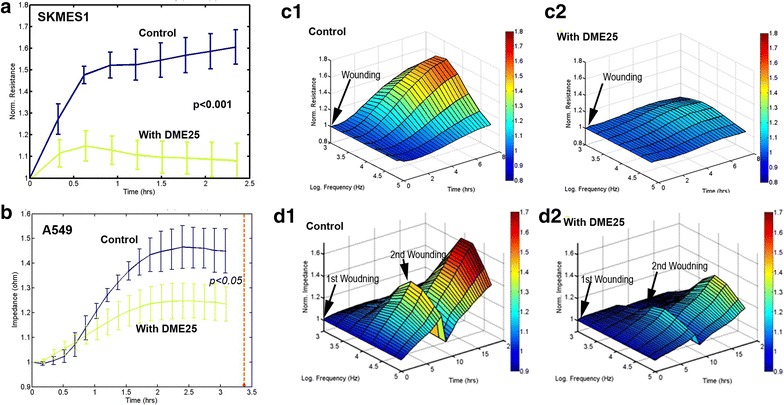Fig. 2.

Electric cell-substrate impedance sensing (ECIS) based evaluation of cell adhesion (a, b) and cellular migration (c, d). a, b Evaluation of cell adhesion by ECIS. The ECIS array was first treated with cysteine for 20 min followed by washing. Medium or tested agents were then pipetted to the respective wells, immediately followed by adding cancer cells to each well. The ECIS unit then immediately began tracking the adhesion of the cells. Shown are traces of the adhesion of the respective cells. Cell adhesion of SKMES1 and A549 to matrix was markedly inhibited by YangZheng XiaoJi (shown is the extract used at 1:1000). Error bars shown are standard deviation (n = 4). YangZheng XiaoJi significantly inhibited the adhesion of both cells (p < 0.05, control vs DME25 treatment). c Effects of YangZheng XiaoJi on the migration of SKMES1 cells analysed by ECIS. SKMES1 cells, after reaching confluence, were electrically wounded (indicated by arrow). After replacing the medium with fresh medium contained test agent, the pace of migration was immediately traced. Shown are the cell response in a 3-D model: resistance in y-axis (ohms), over a 7-h period (z-axis) and across 7 frequencies (1000, 2000, 4000, 8000, 16,000, 32,000 and 64,000 Hz) (x-axis). Observations were made with multiple frequencies in order to track if cell behaviour can be viewed differently over a broad spectrum of frequencies. The cellular migration of SKMES1 after electric wounding was suppressed by YangZheng XiaoJi (c2), compared with control (c1). d Effects of YangZheng XiaoJi on the migration of A549 cells analysed by ECIS. Test condition was the same as SKMES1 in (c), except that 7 h after the first round of wounding, a second wounding assay was applied, in order to evaluate the reproducibility of the same cell in the same model (indicated by the 2nd arrow in d1, d2). Similarly, the migration of A549 (d) was also inhibited by YangZheng XiaoJi. The A549 cells were repeatedly wounded and a similar inhibition was seen (d). c, d y-axis: resistance (ohms); x-axis: frequencies in Hz; z-axis: time in hours
